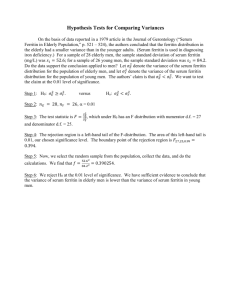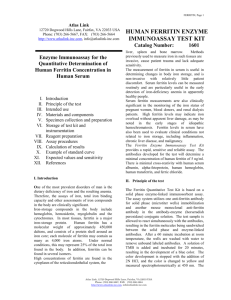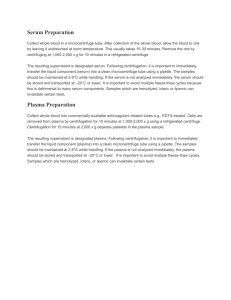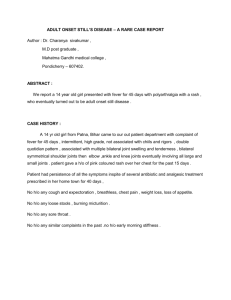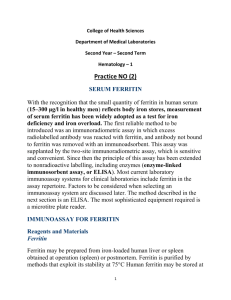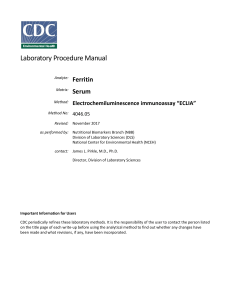Birthplace
advertisement
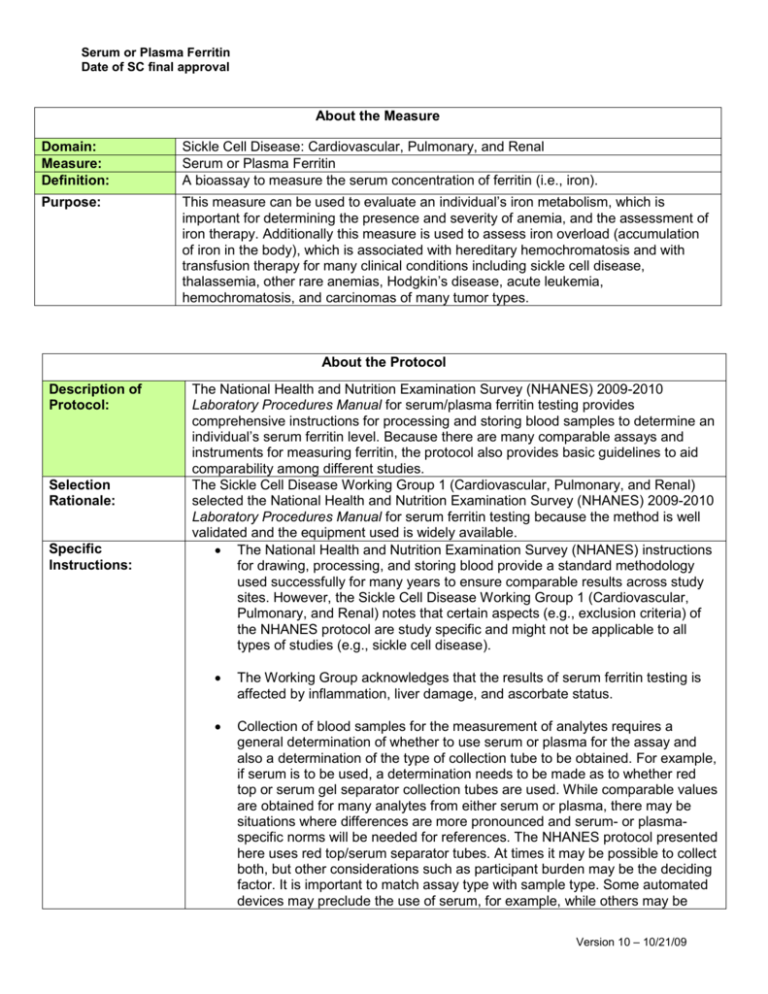
Serum or Plasma Ferritin Date of SC final approval About the Measure Domain: Measure: Definition: Sickle Cell Disease: Cardiovascular, Pulmonary, and Renal Serum or Plasma Ferritin A bioassay to measure the serum concentration of ferritin (i.e., iron). Purpose: This measure can be used to evaluate an individual’s iron metabolism, which is important for determining the presence and severity of anemia, and the assessment of iron therapy. Additionally this measure is used to assess iron overload (accumulation of iron in the body), which is associated with hereditary hemochromatosis and with transfusion therapy for many clinical conditions including sickle cell disease, thalassemia, other rare anemias, Hodgkin’s disease, acute leukemia, hemochromatosis, and carcinomas of many tumor types. About the Protocol Description of Protocol: Selection Rationale: Specific Instructions: The National Health and Nutrition Examination Survey (NHANES) 2009-2010 Laboratory Procedures Manual for serum/plasma ferritin testing provides comprehensive instructions for processing and storing blood samples to determine an individual’s serum ferritin level. Because there are many comparable assays and instruments for measuring ferritin, the protocol also provides basic guidelines to aid comparability among different studies. The Sickle Cell Disease Working Group 1 (Cardiovascular, Pulmonary, and Renal) selected the National Health and Nutrition Examination Survey (NHANES) 2009-2010 Laboratory Procedures Manual for serum ferritin testing because the method is well validated and the equipment used is widely available. The National Health and Nutrition Examination Survey (NHANES) instructions for drawing, processing, and storing blood provide a standard methodology used successfully for many years to ensure comparable results across study sites. However, the Sickle Cell Disease Working Group 1 (Cardiovascular, Pulmonary, and Renal) notes that certain aspects (e.g., exclusion criteria) of the NHANES protocol are study specific and might not be applicable to all types of studies (e.g., sickle cell disease). The Working Group acknowledges that the results of serum ferritin testing is affected by inflammation, liver damage, and ascorbate status. Collection of blood samples for the measurement of analytes requires a general determination of whether to use serum or plasma for the assay and also a determination of the type of collection tube to be obtained. For example, if serum is to be used, a determination needs to be made as to whether red top or serum gel separator collection tubes are used. While comparable values are obtained for many analytes from either serum or plasma, there may be situations where differences are more pronounced and serum- or plasmaspecific norms will be needed for references. The NHANES protocol presented here uses red top/serum separator tubes. At times it may be possible to collect both, but other considerations such as participant burden may be the deciding factor. It is important to match assay type with sample type. Some automated devices may preclude the use of serum, for example, while others may be Version 10 – 10/21/09 Serum or Plasma Ferritin Date of SC final approval Protocol Text: optimized for it. Investigators should choose methods of collection that match the methods of analysis. This will best be done by communicating with the laboratory where the proposed assays will be performed. They will become an important partner with you in ensuring that there is compatibility from collection to assays to interpretation and reporting of levels and results The following is a summary version of the full National Health and Nutrition Examination Survey protocol. Exclusion Criteria Persons will be excluded from this component if they: • Report that they have hemophilia; or • Report that they have received cancer chemotherapy in the last 4 weeks SP = Sample Person. 1. Do you have hemophilia? 1[] 2[] 7[] 9[] Yes No Refused Don’t Know If the SP answers "Yes," the SP is excluded from the blood draw. If SP answers "No" or "Don’t Know," blood is drawn from the SP. 2. Have you received cancer chemotherapy in the past four weeks or do you anticipate such therapy in the next four weeks? 1 [ ] Yes 2 [ ] No 7 [ ] Refused 9 [ ] Don’t Know If the SP answers "Yes," the SP is excluded from the blood draw. If SP answers "No" or "Don’t Know," blood is drawn from the SP. Venipuncture Procedures Editor’s Note: Please review chapter 4 of the Laboratory Procedures Manual from the 2009-2010 National Health and Nutrition Examination Survey (NHANES) for a full description of phlebotomy procedures. This manual is posted here, and is also available at the NHANES website: http://www.cdc.gov/nchs/data/nhanes/nhanes_09_10/lab.pdf Venipuncture should generally be performed using the median cubital, cephalic, or basilic veins in the left arm unless this arm is unsuitable. If the veins in the left arm are unsuitable, look for suitable veins on the right arm. If the veins in the antecubital Version 10 – 10/21/09 Serum or Plasma Ferritin Date of SC final approval space on both arms are not suitable, then look for veins in the forearm or dorsal side of the hand on the left arm/hand and then the right arm/hand. Fill a 3 or 4 ml K3 EDTA tube with blood. Recording the Results of the Venipuncture Procedure Immediately after completing the venipuncture, record the results of the blood draw, the reasons for a tube not being drawn according to the protocol, and any comments about the venipuncture. Collection tube should be standardized across the study duration. Laboratory Assay for Ferritin The Sickle Cell Disease Working Group 1 (Cardiovascular, Pulmonary, and Renal) notes that there are a number of different assays and instruments that are appropriate to measure ferritin. Once an assay is chosen for a particular study, the Working Group recommends that no changes in the protocol be made over the course of the study. To aid comparability, the Working Group recommends that the investigator record the make and manufacturer of equipment used and the repeatability and coefficients of variation for the assay. Reference Ranges (Normal Values) for Ferritin Ferritin reference ranges are assay-specific. The Roche Diagnostics kit used by NHANES specifies expected values of 30-400 ng/mL for men and 13-150 ng/mL for women. Participant: Source: Language of Source: Note: A full description of the National Health and Nutrition Examination Survey procedure for serum ferritin testing can be found in the 2009-2010 Laboratory Procedure Manual posted here, and is also available at the NHANES website: http://www.cdc.gov/nchs/data/nhanes/nhanes_09_10/FERTIN_F_met_ferritin.pdf All ages Centers for Disease Control and Prevention (CDC). (2009). National Health and Nutrition Examination Survey Questionnaire. Laboratory Procedures Manual. Hyattsville, MD: U.S. Department of Health and Human Services, Centers for Disease Control and Prevention. English Personnel and Training Required: Equipment Needs: Phlebotomist Protocol Type: Bioassay Laboratory that can perform the serum ferritin test. Requirements: Requirements Category Major equipment Required (Yes/No): No Version 10 – 10/21/09 Serum or Plasma Ferritin Date of SC final approval Common Data Elements: General References: Specialized training No Specialized requirements for biospecimen collection Average time of greater than 15 minutes in an unaffected individual TBD by PhenX Team No No Adamkiewicz, T. V., Abboud, M. R., Paley, C., Olivieri, N., Kirby-Allen, M., Vichinsky, E., Casella, J. F., Alvarez, O. A., Barredo, J. C., Lee, M. T., Iyer, R. V., Kutlar, A., McKie, K. M., McKie, V., Odo, N., Gee, B., Kwiatkowski, J. L., Woods, G. M., Coates, T., Wang, W., & Adams, R. J. (2009). Serum ferritin level changes in children with sickle cell disease on chronic blood transfusion are nonlinear and are associated with iron load and liver injury. Blood, 114(21), 4632-4638. Drasar, E., Vasavda, N., Igbineweka, N., Awogbade, M., Allman, M., & Thein, S.L. (2012). Serum ferritin and total units transfused for assessing iron overload in adults with sickle cell disease. British Journal of Haematology, 157(5), 645-647. Additional Information About the Measure Essential Data: Gender, Current age, Race, Ethnicity Related PhenX Measures: Derived Variables: Keywords/Related Concepts: None None Serum ferritin, plasma ferritin, iron, anemia, sickle cell disease, SCD, thalassemia, iron overload, hereditary hemochromatosis, iron deficiency, cancer, lung, colon, liver, prostate, acute leukemia, Hodgkin’s disease, hemochromatosis, carcinoma, NHANES Version 10 – 10/21/09
